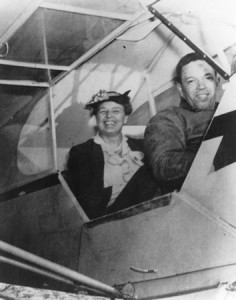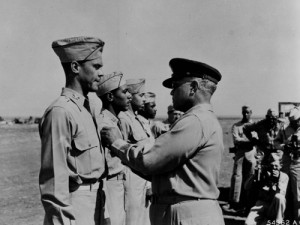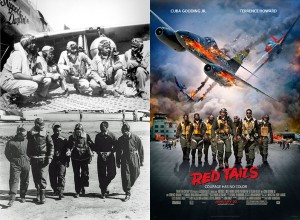By Clint Van Winkle
In an era when African-Americans were treated like sub-humans, a group of African-Americans were flying the most advanced technology the U.S. military had to offer. These WWII-era pilots, along with support crew, are known as the Tuskegee Airmen. Although there were a number of Tuskegee units in the Army Air Corps, the units who flew red-tailed P-51 Mustangs are the best known. They are also the subject of George Lucas’s new WWII extravaganza Red Tails, Starring Cuba Gooding Jr. and Terrence Howard.
Visually, it’s appealing. Action scenes? Great. Everything else?
Rather than focusing on the exploits of actual Tuskegee Airmen, Lucas spent $98 million to produce and promote a story about fictionalized characters. Its comic book feel and loose interpretation of their history does nothing to capture an incredibly tense time. The Tuskegee Airmen’s true story, without the Hollywood glitter, is amazing on its own.
The story of the real “Red Tails” began at Tuskegee Army Airfield, a base built exclusively for training African-American military pilots. Located in the heartland of racism, views contained in “The Use of Negro Manpower in War,” an official U.S. Army report, were still widely accepted. Published in 1925, the report concluded that black men were “very low in the scale of human evolution.” The first class of thirteen men set out to make history and to change the status quo. Five airmen earned their wings in March 1942. They became the 99th Pursuit (later Fighter) Squadron.

Efforts to educate the American public—and remove doubts regarding the airmen’s abilities—took root and continued throughout the war effort. First Lady Eleanor Roosevelt flew with an African-American pilot at Tuskegee; War Bond posters featuring the airmen were circulated; and Ronald Reagan narrated a pro-Tuskegee film titled Wings for this Man (1945), saying about an already very accomplished Tuskegee unit:
“One thing was proved here: that you can’t judge a man by the color of his eyes or the shape of his nose.”
The 99th deployed to North Africa in 1943 and, while flying P-40s, was tasked with missions that kept them from engaging in air-air combat—a sign higher-ups doubted their abilites. They were later joined by the 100th, the 301st, and the 302nd. The four squadrons comprised the 332nd Fighter Group.
When the 332nd was reassigned, it was tasked with escorting the heavy bombers of the Fifteenth Air Force into enemy territory. The airmen were entrenched in the business of aerial combat. They received P-51s a month later and, in July 1944, their famous red-tailed planes took to the air.
Although they received the missions they’d wanted, racism still plagued the unit. They had more to prove than the average pilots.
Up against them: Out of all the units that flew P-51s in the Fifteenth Air Force, the 332nd scored the lowest number of aerial victories—and it didn’t have a single Ace pilot, either. These stats were used against the Tuskegee Airmen, used to buttress claims that they were unskilled pilots because of their skin color.
However, the claims fall flat against this stat: Average number of bombers lost during escorts? Forty-six. The Tuskegee Airmen lost 27.
The airmen had been told to protect bombers. Rather than breaking away to engage enemy pilots, they stayed close to the bombers they were escorting. It was a tactic that worked. They lost the personal glory that came with dog fighting, but they kept Americans alive. Mission accomplished.

The 332nd’s toughest mission occurred March 24, 1945. Tasked with escorting bombers deep into enemy territory, the Tuskegee Airmen, along with four other escort groups, flew a 1,600-mile roundtrip mission to Berlin. Led by Benjamin O. Davis Jr., the son of the first African-American general ever in the U.S. Military, and a member of the very first Tuskegee class, the 332nd helped to bring every bomber back safe. The mission to Berlin and back earned the 332nd a Distinguished Unit Citation. Years later, Davis, Jr. became U.S. Air Force’s first African-American general officer and eventually achieved the rank of Lt. General (three stars).
Training African-Americans to fly for the U.S. military began as an experiment. The men who took the challenge and willingly served a country that marginalized their existence were trailblazers—in the truest sense. Unfortunately, Red Tails doesn’t showcase General Davis or any of the other real-life heroes.
While Red Tails strays from history, even including a scene where a lone P-51 sinks a Nazi Battleship, an oft repeated piece of Tuskegee Airmen lore that historians say never happened (see the Air Force Historical Research Agency’s “Nine Myths About the Tuskegee Airmen”), the film does give the Tuskegee Airmen a chest-pounding action flick of its own. It also succeeds in bringing the tale, however stretched, to a younger generation and putting the airmen back in the news. Hopefully, viewers will realize the film is a dramatization and take the time to learn about the real Red Tails. Their rich story is complex. A movie or online article cannot do their service justice.

Clockwise from top left. Ramitelli, Italy, March 1945 (from left): Lt. Dempsey W. Morgan, Lt. Carrol S. Woods, Lt. Robert H. Nelson Jr., Capt. Andrew D. Turner and Lt. Clarence D. Lester were pilots with the 332nd Fighter Group. Photo and caption credit: U.S. Air Force. Poster for Red Tails film, starring Cuba Gooding, Jr., and Terrence Howard. First graduating class of African American pilots in U.S. Army Air Corps, at Advanced Flying School, Tuskegee, Alabama: G.S. Roberts, B.O. Davis, C.H. DeBow, R.M. Long, Mac Ross, and L.R. Curtis. Caption credit: National Archives. Photo Credit: Air Force.
CLINT VAN WINKLE is the author of Soft Spots: A Marine’s Memoir of Combat and Post-Traumatic Stress Disorder and an Operation In Their Boots filmmaker (click here to watch his film, “The Guilt”, which premiered Nov. 9, 2010 in Los Angeles. While in Iraq he served as an Amphibious Assault Vehicle section leader, attached to Lima Company 3rd BN 1st Marines, and commanded eighteen other Marines. After completing his enlistment, Van Winkle earned a BA in English from Arizona State University, then a MA in Creative and Media Writing from the University of Wales-Swansea, and began to publish pieces of this book in literary magazines. He currently in Phoenix, AZ with his wife Sara and teaches at Arizona State University’s West Campus.Visit his website link for more information.
